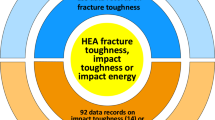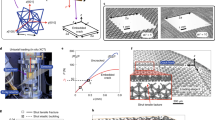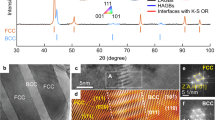Abstract
The attainment of both strength and toughness is a vital requirement for most structural materials; unfortunately these properties are generally mutually exclusive. Although the quest continues for stronger and harder materials, these have little to no use as bulk structural materials without appropriate fracture resistance. It is the lower-strength, and hence higher-toughness, materials that find use for most safety-critical applications where premature or, worse still, catastrophic fracture is unacceptable. For these reasons, the development of strong and tough (damage-tolerant) materials has traditionally been an exercise in compromise between hardness versus ductility. Drawing examples from metallic glasses, natural and biological materials, and structural and biomimetic ceramics, we examine some of the newer strategies in dealing with this conflict. Specifically, we focus on the interplay between the mechanisms that individually contribute to strength and toughness, noting that these phenomena can originate from very different lengthscales in a material's structural architecture. We show how these new and natural materials can defeat the conflict of strength versus toughness and achieve unprecedented levels of damage tolerance within their respective material classes.
This is a preview of subscription content, access via your institution
Access options
Subscribe to this journal
Receive 12 print issues and online access
$259.00 per year
only $21.58 per issue
Buy this article
- Purchase on Springer Link
- Instant access to full article PDF
Prices may be subject to local taxes which are calculated during checkout





Similar content being viewed by others
References
Olson, G. B. & Cohen, M. in Dislocations in Solids Vol. 7 (ed. Nabarro, F. R. N.) Ch. 37, 295–407 (North-Holland, 1986).
Gupta, H. S. et al. Nanoscale deformation mechanisms in bone. Nano Lett. 5, 2108–2111 (2005).
Wang, R. Z. et al. Deformation mechanisms in nacre. J. Mater. Res. 16, 2485–2493 (2001).
Vashishth, D. Rising crack-growth-resistance behavior in cortical bone: Implication for toughness measurements. J. Biomech. 37, 943–946 (2003).
Conner, R. D. et al. Shear bands and cracking of metallic glass plates in bending. J. Appl. Phys. 94, 904–911 (2003).
Evans, A. G. Perspective on the development of high-toughness ceramics. J. Am. Ceram. Soc. 73, 187–206 (1990).
Ritchie, R. O. Mechanisms of fatigue crack-propagation in metals, ceramics and composites: Role of crack tip shielding. Mater. Sci. Eng. A 103, 15–28 (1988).
Launey, M. E. & Ritchie, R. O. On the fracture toughness of advanced materials. Adv. Mater. 21, 2103–2110 (2009).
Hoffman, D. C. et al. Designing metallic glass matrix composites with high toughness and tensile ductility. Nature 451, 1085–1090 (2008).
Launey, M. E. et al. Fracture toughness and crack resistance curve behavior in metallic glass matrix composites. Appl. Phys. Lett. 94, 241910 (2009).
Demetriou, M. et al. A damage-tolerant glass. Nature Mater. 10, 123–128 (2011).
Gilbert, C. J. et al. Crack-growth resistance-curve behavior in silicon carbide: Small versus long cracks J. Am. Ceram. Soc. 80, 2253–2261 (1997).
Clarke, D. R. & Thomas, G. Microstructures of Y2O3 fluxed hot-pressed silicon nitride. J. Am. Ceram. Soc. 60, 491–495 (1978).
Meyers, M. A. et al. Mechanical strength of abalone nacre: Role of the soft organic layer. J. Mech. Behav. Biomed. Mater. 1, 76–85 (2008).
Weiner S. & Wagner H. D. The material bone: Structural-mechanical functional relations. Ann. Rev. Mater. Sci. 28, 271–298 (1998).
Aizenberg, J. & Fratzl, P. Biological and biomimetic materials. Adv. Mater. 21, 387–388 (2009).
Ortiz, C. & Boyce, M. C. Materials science - Bioinspired structural materials. Science 319, 1053–1054 (2008).
Launey, M. E., Buehler, M. J. & Ritchie R. O. On the mechanistic origins of toughness in bone. Ann. Rev. Mater. Res. 40, 25–53 (2010).
Bailey, A. J. Molecular mechanisms of ageing in connective tissues. Mech. Ageing Dev. 122, 735–755 (2001).
Nalla, R. K., Kinney, J. H. & Ritchie, R. O. Mechanistic fracture criteria for the failure of human cortical bone. Nature Mater. 2, 164–168 (2003).
Koester, K. J., Ager, J. W. III & Ritchie, R. O. How tough is human bone? In situ measurements on realistically short cracks. Nature Mater. 7, 672–677 (2008).
Sarikaya, M. & Aksay, I. A. in Results and Problems in Cell Differentiation Vol. 19 (ed. Case, S.) Ch. 1 (Springer, 1992).
Mayer, G. New classes of tough composite materials - Lessons from natural rigid biological systems. Mater. Sci. Eng. C 26, 1261–1268 (2006).
Barthelat, F. & Espinosa, H. D. An experimental investigation of deformation and fracture of nacre-mother of pearl. Exp. Mech. 47, 311–324 (2007).
Munch, E. et al. Tough, bio-inspired hybrid materials. Science 322, 1516–1520 (2008).
Deville, S., Saiz, E., Nalla, R. K. & Tomsia, A. P. Freezing as a path to build complex composites. Science 311, 515–518 (2006).
Acknowledgements
This work was supported by the Director, Office of Science, Office of Basic Energy Sciences, Division of Materials Sciences and Engineering, of the U.S. Department of Energy under Contract No. DE-AC02-05CH11231. Particular thanks to A. P. Tomsia and E. Launey for their help with this paper.
Author information
Authors and Affiliations
Corresponding author
Ethics declarations
Competing interests
The author declares no competing financial interests.
Rights and permissions
About this article
Cite this article
Ritchie, R. The conflicts between strength and toughness. Nature Mater 10, 817–822 (2011). https://doi.org/10.1038/nmat3115
Published:
Issue Date:
DOI: https://doi.org/10.1038/nmat3115
This article is cited by
-
Multifunctional metallic nanocomposite for overcoming the strength–ductility trade-off
Scientific Reports (2024)
-
A strong fracture-resistant high-entropy alloy with nano-bridged honeycomb microstructure intrinsically toughened by 3D-printing
Nature Communications (2024)
-
High fatigue resistance in a titanium alloy via near-void-free 3D printing
Nature (2024)
-
On the Micro-Stress Fields in Fibre-Hybrid Polymer Composite Laminae with Periodic Microstructure Under Transverse Tension and Transverse Shear Loading
Applied Composite Materials (2024)
-
Novel as-cast Ti-rich refractory complex concentrated alloys with superior tensile properties
Science China Materials (2024)



